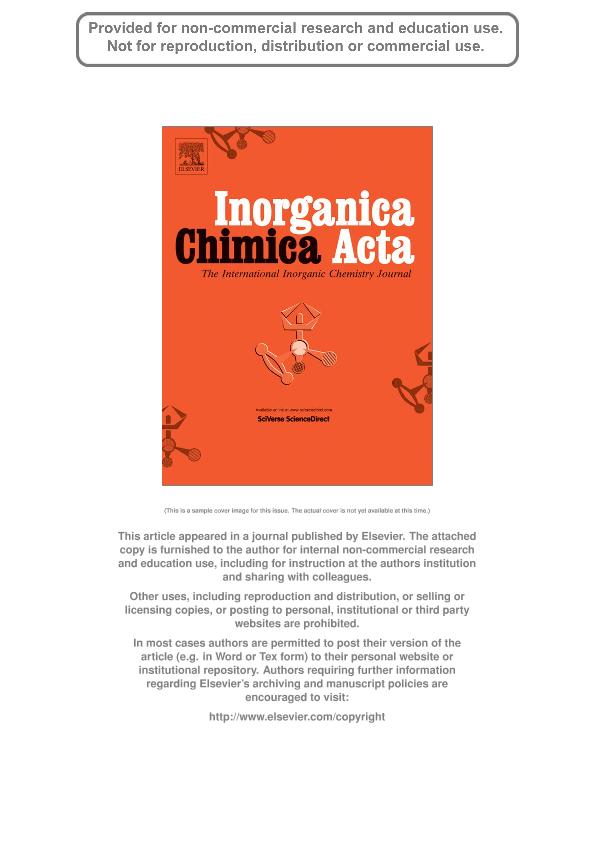Mostrar el registro sencillo del ítem
dc.contributor.author
Freire Espeleta, Eleonora

dc.contributor.author
Quintero, Mariano Horacio

dc.contributor.author
Vega, Daniel Roberto

dc.contributor.author
Baggio, Ricardo Fortunato

dc.date.available
2019-06-10T18:35:41Z
dc.date.issued
2013-01
dc.identifier.citation
Freire Espeleta, Eleonora; Quintero, Mariano Horacio; Vega, Daniel Roberto; Baggio, Ricardo Fortunato; Crystal structure and magnetic properties of two new zoledronate complexes: A Mn dimer [Mn(II)(H3Zol)2·(H2O)2] and a Fe15 molecular cluster [Fe(III)15(HZol)10(H2Zol)2 (H2O)12(Cl4:(H2O)2)·Cl7·(H2O)65] (where H4Zol: C5H10N2O7P2 is zoledronic acid); Elsevier Science Sa; Inorganica Chimica Acta; 394; 1-2013; 229-236
dc.identifier.issn
0020-1693
dc.identifier.uri
http://hdl.handle.net/11336/77857
dc.description.abstract
The synthesis, X-ray structure and magnetic properties of two new zoledronato complexes are presented: Mn(II)(H3Zol)2(H 2O)2, (I) and Fe(III)15(HZol) 10(H2Zol)2 (H2O)24 (2/3Cl:1/3H2O)6·7Cl·65(H2O) (II), where H4Zol = zoledronic acid = C5H10N 2O7P2. Complex (I) is a dimer, built up around an inversion centre where the cation is located, surrounded by two chelating zoledronate anions and two water molecules. The structure is isomorphous to the Co, Ni and Zn isologues. A quite different structure is the Fe(III) complex which consists of a centrosymmetric cluster with 15 Fe(III) cations (one of them at the inversion centre), 12 zoledronate anions, in different protonation states and 26 coordinated water molecules, 24 of which show full occupancy and the remaining 2 share 6 coordination sites with 4 chlorine anions. There are in addition 7 chlorine counterions and a not well determined number of hydration water molecules, their number being adjusted as to match the chemical and TGA analysis. The general shape of the molecule is that of a 6 arm propeller with a Fe(III) cation at its center and two FeO6 coordination polyhedra sitting above and below, defining some sort of "paddle wheel axis", perpendicular to the wheel plane. Around this axis there is an almost perfect circular structure formed by other six FeO6 octahedra, to which the "paddles", defined by the remaining six FeO6 groups attach. The ensemble presents some unusual (Fe···OPO)n loops (n = 2,3,4), some of them unreported, and displays a striking non-crystallographic -3 symmetry. The protonation state of the zoledronato ligands were inferred from the counterions effectively found and charge balance considerations. Both compounds present a paramagnetic behaviour at R.T, and obey a Curie Weiss law down to rather low temperatures (15 K for (I), 100(K) for (II)) with a tendency to different types of interactions viz., ferromagnetic for (I) and antiferromagnetic for (II). The geometry of the F15 cluster is analyzed. © 2012 Elsevier B.V. All rights reserved.
dc.format
application/pdf
dc.language.iso
eng
dc.publisher
Elsevier Science Sa

dc.rights
info:eu-repo/semantics/openAccess
dc.rights.uri
https://creativecommons.org/licenses/by-nc-sa/2.5/ar/
dc.subject
Fe15 Iron Cluster
dc.subject
Magnetic Behaviour
dc.subject
Zoledronate Complexes
dc.subject.classification
Otras Ciencias Químicas

dc.subject.classification
Ciencias Químicas

dc.subject.classification
CIENCIAS NATURALES Y EXACTAS

dc.title
Crystal structure and magnetic properties of two new zoledronate complexes: A Mn dimer [Mn(II)(H3Zol)2·(H2O)2] and a Fe15 molecular cluster [Fe(III)15(HZol)10(H2Zol)2 (H2O)12(Cl4:(H2O)2)·Cl7·(H2O)65] (where H4Zol: C5H10N2O7P2 is zoledronic acid)
dc.type
info:eu-repo/semantics/article
dc.type
info:ar-repo/semantics/artículo
dc.type
info:eu-repo/semantics/publishedVersion
dc.date.updated
2019-06-07T14:33:34Z
dc.journal.volume
394
dc.journal.pagination
229-236
dc.journal.pais
Países Bajos

dc.journal.ciudad
Amsterdam
dc.description.fil
Fil: Freire Espeleta, Eleonora. Consejo Nacional de Investigaciones Científicas y Técnicas; Argentina. Comisión Nacional de Energía Atómica. Centro Atómico Constituyentes; Argentina. Universidad Nacional de San Martín. Escuela de Ciencia y Tecnología; Argentina
dc.description.fil
Fil: Quintero, Mariano Horacio. Consejo Nacional de Investigaciones Científicas y Técnicas; Argentina. Comisión Nacional de Energía Atómica. Centro Atómico Constituyentes; Argentina. Universidad Nacional de San Martín. Escuela de Ciencia y Tecnología; Argentina
dc.description.fil
Fil: Vega, Daniel Roberto. Consejo Nacional de Investigaciones Científicas y Técnicas; Argentina. Comisión Nacional de Energía Atómica. Centro Atómico Constituyentes; Argentina. Universidad Nacional de San Martín. Escuela de Ciencia y Tecnología; Argentina
dc.description.fil
Fil: Baggio, Ricardo Fortunato. Comisión Nacional de Energía Atómica. Centro Atómico Constituyentes; Argentina
dc.journal.title
Inorganica Chimica Acta

dc.relation.alternativeid
info:eu-repo/semantics/altIdentifier/url/https://www.sciencedirect.com/science/article/pii/S0020169312004409
dc.relation.alternativeid
info:eu-repo/semantics/altIdentifier/doi/https://doi.org/10.1016/j.ica.2012.06.045
Archivos asociados
